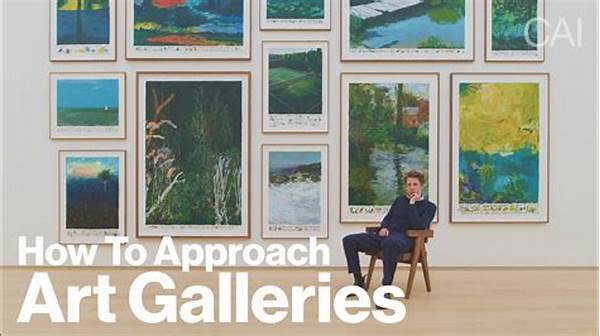When considering how to approach art galleries, it’s important to strike the right balance between professionalism and creativity. Galleries are the gatekeepers to the art world, and making a good first impression can lead to successful exhibitions and long-term partnerships. Here, we explore the steps and strategies you need to effectively engage with galleries and make a positive impact in this vibrant sector.
Read Now : Art Network Collaboration Opportunities
Understanding the Gallery’s Profile
Before you even think about how to approach art galleries, it is crucial to do your homework on the galleries you are interested in. Each gallery has a unique profile, catering to specific styles, themes, and types of artwork. By aligning your art with galleries that share a similar vision, you position yourself more favorably for acceptance. Take the time to visit their exhibitions, study their online presence, and if possible, attend events they host. Knowing their curatorial style and the artists they currently support will provide insight into whether your work would be a good fit, thus increasing your chances of a successful approach.
Investing time in understanding the gallery’s audience is another important factor. Consider whether your art speaks to the demographic frequently visiting the gallery. Aligning with their audience can be as important as aligning with their artistic vision. This knowledge not only aids in how to approach art galleries but also in crafting a portfolio that resonates with them. A tailored approach suggests you are committed and serious about establishing a beneficial relationship.
Building relationships with gallery staff is just as critical. Gallery owners and curators appreciate artists who take the time to engage genuinely and respectfully. Knowing their preferences and establishing trust can open doors once you decide to formally present your work. This careful planning reflects seriousness and professionalism when you approach art galleries, setting you apart from artists who may not have taken such diligent steps.
First Impressions and Presentation
Crafting an impeccable first impression is essential when considering how to approach art galleries. Here are five key considerations for presenting yourself professionally:
1. Portfolio Presentation: Ensure your portfolio is well-organized and showcases your strongest work.
2. Personal Brand: Develop a clear and concise artist statement that reflects your artistic identity.
3. Professionalism: Approach galleries with a respectful and positive attitude. Politeness goes a long way.
4. Networking: Attend gallery openings and art fairs to build connections and understand the art scene.
5. Online Presence: Maintain a professional online profile, showcasing your art and any exhibitions or accolades.
Tailoring Your Proposal
When you decide how to approach art galleries, personalizing your proposal is critical. A generic proposal often fails to capture attention in a competitive art market. Galleries receive numerous submissions, so standing out requires a precise and informed approach. Research each gallery’s submission guidelines carefully and tailor the materials you send accordingly. This demonstrates respect for their process and an understanding of their expectations.
Create a distinct narrative around your artwork. This storytelling aspect can engage gallery curators and set your application apart. Highlight not only what your art represents but also its relevance in today’s social or cultural context. An intriguing and coherent proposal helps curators appreciate the value your work can add to their gallery’s existing collection. In the process of how to approach art galleries, showing that your work complements their current oeuvre is invaluable.
Networking and Follow-up
Understanding how to approach art galleries includes knowing how to maintain and nurture relationships:
1. Attend Openings: Familiarize yourself with the gallery’s environment and network.
2. Regular Follow-ups: After initial contact, send gentle follow-up emails showing continued interest.
3. Update Galleries: Keep galleries informed about new projects or exhibitions you’re involved in.
4. Solicit Feedback: If not immediately accepted, ask for constructive feedback and learn from it.
5. Express Gratitude: Always thank the gallery for their time and consideration, regardless of the outcome.
Read Now : Nft Marketplace For Digital Art
6. Be Patient: Building relationships can take time; persistence and patience are key.
7. Keep Learning: Stay informed about the art world trends to ensure your work remains relevant.
8. Stay Humble: Accept criticism with grace and seek ways to improve your practice.
9. Be Flexible: Adapt to suggestions from galleries to increase dialogue and chances of acceptance.
10. Evaluate Partnerships: Assess whether the gallery truly aligns with your artistic goals.
Effective Communication Tactics
Mastering effective communication is essential in how to approach art galleries successfully. Firstly, clarity is paramount; ensure your emails and proposals are succinct, error-free, and professional. Introduce yourself with a brief background, highlighting noteworthy achievements relevant to your proposal. This introduction sets the tone for any subsequent communication.
Secondly, active listening during initial meetings can provide valuable insights into the gallery’s priorities and expectations. Listening carefully allows you to adapt your pitch to resonate with their vision and goals. When you comprehend what the gallery values, you have a better chance of framing your art in a way that aligns with their interests.
Furthermore, expressing genuine enthusiasm and confidence in your work can significantly influence your communication. Passion often translates as authenticity, which can be compelling to gallery owners and curators. While conveying confidence, always remain open to their suggestions and criticism, as adaptability can demonstrate your willingness to collaborate effectively.
Crafting a Successful Follow-Up Strategy
The importance of follow-up cannot be overstated when learning how to approach art galleries. After an initial submission or meeting, a timely and courteous follow-up can reinforce your interest and keep you top of mind. However, this should be done with tact to avoid appearing overly persistent. A brief email thanking the gallery for their time, and summarizing key points of interest discussed, can be very effective.
Provide updates on any new accomplishments or pieces of work relevant to the gallery’s focus. This demonstrates both your progress as an artist and your keen interest in maintaining an ongoing dialogue. Following up also provides an opportunity to glean feedback critical for enhancing future proposals. Remember, patience is crucial; galleries have their schedules and priorities, so respect their timelines and avoid pressuring for a quick response.
By combining personalized follow-ups with consistent communication of your artistic developments, you strengthen the relationship foundation initially established. Even if an immediate opportunity does not arise, your professionalism and persistence may eventually lead to a rewarding collaboration. As you master how to approach art galleries, remember that each interaction builds a stepping stone toward potential opportunities.
Final Thoughts on Approaching Art Galleries
In summary, knowing how to approach art galleries effectively requires a blend of research, professional presentation, and interpersonal skills. By aligning your artwork with the right galleries, you enhance the likelihood of a fruitful partnership. Developing a clear understanding of a gallery’s profile and audience is the first step towards ensuring that your art resonates with their vision.
Continuing to build relationships through networking and skillful communication can serve as a significant advantage. Remember, the art world is both a creative and business environment where mutual respect and understanding are key. Stay persistent but patient, humble yet confident, as these traits are imperative in navigating the world of galleries.
Ultimately, your determination and careful strategy in how to approach art galleries will strengthen your position within the art community. Through perseverance and dedication, artists can create lasting connections with galleries that foster artistic growth and open the doors to exciting exhibition opportunities.



